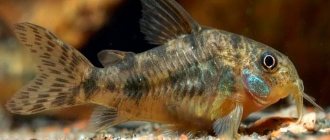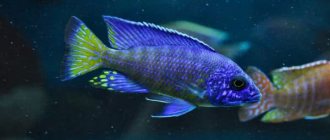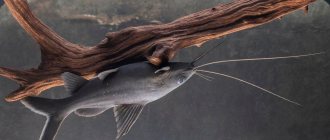The golden catfish or bronze catfish (lat. Corydoras aeneus, also the bronze catfish) is a small and beautiful aquarium fish that comes from the family of armored catfish (Callichthyidae). The family got its name because their body is covered with protective bone plates.
Distinguished by their livability, interesting behavior, small size and beautiful coloring, Corydoras are well suited for experienced and novice aquarists. And the golden catfish is no exception; you will learn further how to keep, feed and breed it.
Content
- 1 Description
- 2 Behavior
- 3 Decoration of the aquarium
- 4 Conditions of detention
- 5 Food
- 6 Reproduction
- Other names: Corydoras aeneus, Bronze Cory, Golden catfish, Variable catfish, Bronze Corydoras.
- Origin: South America.
- Size: up to 7 cm.
- Temperature: 23-26 °C.
- Water parameters: pH 6.5-8, dH 1-25°.
- Behavior: peaceful.
- Additional information: they occupy the lower, bottom level of the aquarium; it is advisable to keep 6 or more individuals in a flock.
- Content difficulty: easy.
Feeding
Corydoras aeneus is omnivorous and will eat anything that falls to its bottom. In order for the fish to develop fully, you need to feed it with a variety of food, with the obligatory addition of live food.
Since the catfish feeds from the bottom, make sure that it gets enough food so that it does not remain hungry after feeding other fish.
Alternatively, you can feed him at night or at sunset. Golden catfish remain active in the dark and will be able to eat to their heart's content.
Behavior
In nature, most Corydoras swim in schools of 10-20 individuals or more; it is advisable to keep them in similar conditions in an aquarium. Therefore, they should be housed in flocks of at least 6-10 individuals. It is good to keep them in a common aquarium with characin fish, livebearers and other small, peaceful fish. Avoid large aggressive fish such as cichlids or large barbs.
If you keep one golden catfish, it will be very shy and timid. In groups, on the contrary, he feels safe and displays very active and funny behavior. They chase each other, dive into filter currents or air currents, and “jump” onto leaves after each other. Their behavior cannot be called very intelligent or unusual, such as that of angelfish, but, of course, they are very entertaining, cute and funny.
Description
Like all corydoras, the golden one is covered with bony plates for protection. In addition, the dorsal, pectoral and adipose fins have additional sharp spines, and when the catfish is frightened, it bristles with them.
This is protection from predators in nature. Pay attention to this when you catch them with a net. You should be careful not to injure the fish, or even better, use a plastic container.
The size of the fish is up to 7 centimeters, with males slightly smaller than females. The average life expectancy is 5-7 years, however, there are cases when catfish lived up to 10 years or more.
The body color is yellowish or pink, the belly is white, and the back is blue-gray. A brownish-orange spot is usually present on the head, just in front of the dorsal fin, and is its most distinctive feature when viewed from top to bottom.
Reproduction
Males are slightly smaller and have a sharper dorsal fin. Since it is advisable to keep Corydoras in a flock, this issue is not urgent. Before spawning, they must be kept on a high-protein diet, which consists of small live food. You should feed several times a day.
Spawning is preceded by a lengthy courtship ritual consisting of fights, interrupted by the cleaning of potential spawning grounds. After courtship is completed, the pair closes in the T-position: the female pushes the male to the side with her head, and he presses her antennae against him with his pectoral spines. When the eggs are fertilized, the pair separates and the female lays the eggs.
Golden catfish often use the walls of the aquarium, a plastic filter box, sponges or plant leaves to lay eggs. After spawning is completed, the eggs must be transferred to the spawning tank, after 2-10 days the fry will appear.
Golden catfish (Corydoras aeneus)
Golden catfish, or golden corydoras, or bronze corydoras, or changeable catfish, or changeable corydoras (Albino corydoras, Bronze corydoras, Bronze catfish) is an unpretentious, peace-loving fish from South America. Lives in water of any chemical composition. Prefers twilight lighting. In aquariums it takes live, plant and combined food. Corydoras are popular armored catfish kept in the aquariums of many hobbyists.
Etymology: the generic name - Corydoras - comes from the Greek. κόρυς (korus) - “helmet, shell” and δορά (doras) - “skin”. The specific name comes from the Latin. aeneus - “bronze”.
Habitat: South America - Venezuela, Trinidad, Colombia. Habitat: freshwater slow channels and lakes with a sandy or silty bottom, less often in stagnant waters. Description: the body is short, high, covered with bone plates in two rows (21-23 plates in the top row, 19-21 in the bottom). There is intestinal breathing. In this regard, fish float to the surface of the water to swallow atmospheric air. The mouth is located at the bottom of the head, with two pairs of sensory antennae that complement the organs of touch and taste. The adipose fin is equipped with hard rays. The large dorsal fin is equipped with a hard spine. The eyes are mobile. Color: a wide shiny dark green stripe runs along the entire body, and above it, not reaching the dorsal fin, there is a narrow luminous stripe of golden color. The back is dark brown, the belly is light. All fins are transparent, brownish. Size: golden catfish grows up to 6-7 cm. Life expectancy: up to 5-10 years.
Related article Leopard catfish (Corydoras leopardus)
Aquarium: general, oblong in shape. Sizes: from 50 l for 4 fish. Water: pH 6.5-8, dH 5-10°, aeration, powerful filtration, weak current. Weekly changes of up to 15-20% water. Temperature: 21-27°C. Golden Corydoras can withstand temperature fluctuations from 15°C to 30°C. Lighting: Prefers twilight lighting. Soil: coarse sand, small smooth pebbles. Plants: thickets of broad-leaved plants planted along the walls of the aquarium; There are bushes of floating plants on the surface of the water. Decoration: driftwood, branches, large stones, caves and other decor.
Albino form
Feeding: in nature, Corydoras feeds on worms, bottom crustaceans, insects and plant organic matter. In aquariums it takes live, plant and combined food. In search of food, it actively stirs up the bottom. Adult fish are fed 2-3 times a day in small portions. Food should be varied. They also eat dead, dying and injured fish that lie on the bottom for too long.
Behavior: golden catfish is an active, schooling fish. The flock should contain at least 4-8 individuals. In the wild, fish crawl out in small groups (about 20-30 individuals) onto mud flats and pick up everything edible. The organs of locomotion are the strong spines of the pectoral fins. Personality: peaceful. Water zone: bottom layer of water. Can be kept with: peaceful, sized fish (guppies, mollies, swordtails, tetras, barbs, zebrafish, discus, rasboras, gourami, dwarf cichlids, plecostomus). Cannot be kept with: large, aggressive fish (cichlids).
Fish breeding: paired or nested spawning (3-5 males and 1 female), can occur both in a general aquarium and in a separate spawning tank. Spawning is stimulated by: seating the spawners for 7-10 days, abundant feeding with live food, daily water changes up to 50-70% of the volume, lowering the water temperature by about 2-5°C. Spawning aquarium with a volume of 20-120 l (depending on the number of fish), water level 20-25 cm, enhanced aeration, several bushes of large-leaved plants (nymphs, anubias, cryptocorynes), natural lighting, active aeration. Water parameters: T 18-28°C, pH 6-7.2, dH up to 12°. The water must be settled. Spawning usually begins in the morning and lasts about two hours. The female lays eggs in the pelvic fins folded together, and then transfers them to a cleaned hard substrate (the walls of the aquarium, a flat stone, a large leaf of a plant). If the fish spawned in a community aquarium, then the eggs must be transferred to a nursery aquarium, otherwise they will be eaten. To do this, eggs can be carefully removed from the glass with a plastic card or a razor, and eggs can be removed from plants with your fingers. The aquarium with eggs is shaded, and methylene blue is added to the water. A sprayer is installed near the clutch of eggs. After 10-12 days, the same fish can be spawned again. Sexual differences: males are sleeker and smaller, they have sharper dorsal and pectoral fins; more brightly colored. Puberty: occurs at the age of 8-12 months.
Related article Speckled catfish (Corydoras paleatus)
Number of eggs: up to 150 yellowish eggs with a diameter of about 2 mm. Incubation period: at 28°C - 3-4 days, at 20°C - up to a week. Offspring: fry swim for 3-5 days. In a nursery aquarium, aeration and filtration are necessary (through an airlift filter with a sponge). The water temperature is maintained within 20-26°C, the water level is no more than 20 cm, and a thin layer of sand is required as a substrate. The fry do not tolerate a sharp decrease in pH and an increase in the content of organic substances in the water, so they change up to 10% of the water volume daily. Don’t forget to periodically siphon the soil. Growth rate: with an abundance of food - fast. By two months, the fry grow up to 3 cm. At the age of 8-9 weeks, the fry acquire adult coloration. Feeding of fry: starting food - “live dust”, ciliates, Artemia nauplii, microworms, then finely chopped tubifex. Removal from parents : after spawning, the spawners are removed.
Comments: Golden catfish do not tolerate salt well. Albino (with a pale pink or orange body and red eyes), green and black forms are available on sale.
Stock images from Depositphotos
Recommendations
The aquarium fish Corydoras is suitable for both beginners and experienced aquarists. Possessing a peaceful character, it gets along well with many fish, except aggressive predators. Undemanding to environmental conditions. He spends most of his time at the bottom, rummaging in the soil, performing the function of an aquarium orderly. Easily reproduces in captivity. With proper care, it will delight its owners with offspring and live up to 15 years.
Previous
FishWhat the corridor itself needs for a comfortable stay
Next
FishEasy to keep pearl gourami
Origin
Bronze corydoras are native to the island of Trinidad, in the West Indies, where they live in the river systems of the central and southern part of the island. The species is now believed to be distributed throughout much of South America, from Colombia and Trinidad in the north, all the way south to the Uruguay-Argentina border. However, there are already more than 150 described species of corydoras, this is one of the largest groups of catfish, and in scientific circles there are doubts that the same species is distributed over such a vast territory.
There are records of bronze corydoras in Argentina, Bolivia, Brazil, Colombia, French Guiana, Guyana, Paraguay, Peru, Suriname, Trinidad and Tobago, and Venezuela, but these appear to be only references to similar varieties rather than a single species.
However, fish sold for the aquarium hobby have been bred commercially in captivity for decades throughout the world, and have long been uncaught in the wild for sale.
In nature, golden corydoras live in slow rivers and streams with shallow muddy water. They are also found in fast rivers and standing reservoirs, and in swamps.
Breeding
Golden catfish are suitable for beginner aquarists. It is easy to keep, omnivorous and easy to reproduce. In order to get offspring, the fish are prepared for the mating season in advance. Live food is introduced into the diet, a large volume of water is regularly changed and the temperature is gradually reduced slightly.
You can understand that the pets are ready for spawning by their behavior, when the males begin to chase the female everywhere and tickle her with their whiskers, which means the process has begun. The female cleans a certain place in the tank, where she will take the eggs after fertilization.
During the mating process, the female irritates the male's abdomen with his mustache, he releases milk, into which the mother immediately places eggs, swept seconds earlier. She takes the future offspring to a previously prepared place, where spawning occurs. The process may take several days. The offspring is up to 300 eggs.
Reproduction is best done in a separate spawning aquarium. Immediately after mating is completed, adults are placed back into the common tank.
After a few days, the caviar begins to darken. A little later, the fry appear, they feed on yolk sacs, and already on the 4th day they begin to be given ciliates, crushed catfish food and shrimp, gradually increasing the food to the usual size.
For the health of young animals, water is changed every day (10% of the capacity) throughout the entire growth period.
Compatibility with other fish
Possessing a peaceful and calm disposition, the Corydoras aquarium fish spends most of its time at the bottom of the reservoir. Therefore, it is compatible with many types of fish of a similar size.
Get along well with fish:
- guppy;
- gourami;
- zebrafish;
- swordtails;
- scalars;
- platies;
- discus;
- mollies;
- cockerels, etc.
Cohabitation with eels, shrimp, and barbs develops differently. And there are fish with which Corydoras cannot be housed:
- African and South American cichlids;
- Koi carp;
- astronotuses;
- goldfish;
- large predatory aquarium fish.
What to feed Corydoras?
Corydoras are unpretentious in food. They use what they find at the bottom.
As food the fish are given:
- daphnia;
- bloodworm;
- catfish tablets with herbal ingredients;
- tubifex (live or frozen);
- worms (whole or cut).
Fish also love dry and granular food.
Food for platidoras, as for other bottom-dwelling fish, should be chosen submersible.
Diseases and prevention
Bronze Corridor is distinguished by its endurance and good immunity. With proper care, the fish will not get sick. Problems arise only when there is contact with infected neighbors or when the reservoir is heavily polluted.
When purchasing a pet, they inspect it. The scales should be smooth and bright, without growths or clouding. If reddish spots are found on the abdomen, there is an infectious infection, and it is no longer possible to save the catfish.
Difficulty breathing heavily is a sign of nitrogen poisoning. After observing the individual of interest, one can also note lethargy and apathy.
If they suspect the slightest sign of illness, they postpone the purchase. It is not advisable to take a pet from this container.
Before adding a new fish to a community aquarium, it is kept in quarantine. Fill a separate container with water and drop a few drops of Antipar into it. After some time, you can move the fish to the others.
Appearance
The golden catfish has a convex, straight abdomen. Males have a pointed dorsal fin, while females have a rounded one. A shiny dark green line runs through the body, starting from the gills to the caudal fin. There is a shimmering golden stripe at the head and on the front of the body. The head and dorsal part are dark brown, the abdomen is yellowish. The eyes are yellow with a black pupil, the fins are transparent with a golden tint. The body and dorsal fin are covered with protective spines. Males are smaller than females, 5-6 cm, females reach 7 cm in length.
Corydoras differ from other representatives of the genus Corydoras by various color variations. There are bronze, green, white (albinos), black. But some sellers deliberately inject them bronze. This may enhance the color, but it will degrade the overall condition of the fish.
At home he is active, undemanding and peaceful. Lives at the bottom, constantly processing sand.











